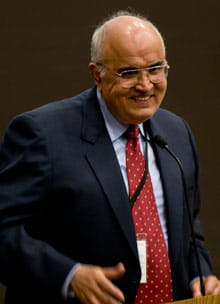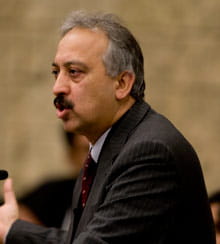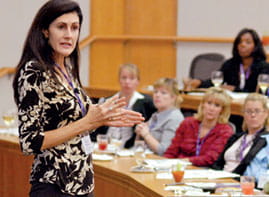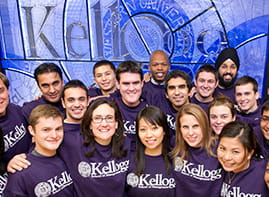Experts at Kellogg conference explore ‘Brand India’ and the challenge of a fragmented market
5/14/2008 - Multiple languages, religions and political views are some of the hurdles facing those doing business in India, according to experts at the May 10 Kellogg School India Business Conference.
| |
 |
Related Video |
|
| |
| |
|
| Other challenges include the country’s often shoddy infrastructure and a massive dichotomy between urban up-and-comers and the rural poor, who constitute 70 percent of India’s nearly 1.2 billion citizens.
“There is no one India,” said Atul Singh, president and CEO of Coca-Cola India, during his keynote address at the daylong conference, which attracted some 400 practitioners and academics as it celebrated its 14th year. The student-led event, the first of its kind, highlighted two Kellogg strengths — marketing and a global management perspective — taking as its theme “Branding India, Indians and Indianness.”
Singh presented demographic details that captured some of the complexity awaiting those who would tap the commercial possibilities of the world’s largest democracy. India is a young and developing country where English is widely spoken, he noted, with a third of its population under the age of 14. Incomes are rising — some 25 percent since 2005 — part of an overall economic scene that has hurtled along at an 8.5 percent rate over the last four years and which, despite a slow start, has made great strides since the implementation of reforms in 1991. While infrastructure deficiencies remain a problem, investment in this area has increased dramatically this decade and consumer confidence is at an all-time high, said Singh.
“Consumers are on a spending spree,” he stated. “The numbers are absolutely staggering,” particularly with respect to communications technology like cell phones.
Indian youth are especially optimistic. But there is a catch: They believe that they personally will be successful, but that their country may not share in that reward — a position precisely the inverse of their Chinese counterparts, said Singh.
 |
| Kanwal Rekhi, managing director of Inventus Capital Partners, delivered a keynote address at the May 10 Kellogg India Business Conference. A veteran entrepreneur, Rekhi shared his perspective on technology and innovation. |
| Photo © Nathan Mandell |
| |
 |
| Keynote speaker Atul Singh, president and CEO, Coca-Cola India, told attendees of the May 10 Kellogg India Business Conference that Indian consumers “are on a spending spree,” but that challenges remain for those looking to reach this vast market. |
| Photo © Nathan Mandell |
Part of the reason for this view is that other key markers of living standards remain subpar. Adult literacy is about 52 percent while life expectancy is still relatively low: 69 years, or 143rd out of the 223 nations scored by the Central Intelligence Agency. (The United States, by comparison, is ranked 47th). Measures of “human development,” a figure produced by the United Nations that attempts a holistic assessment of social capital, ranked India 128 out of 177 countries in 2005. (Singh said India has since inched up to 115.)
But in fact many leaders do worry about the demands that the Indian market places on them. As if conventional competitive pressures were not enough, companies also need to understand that many Indians expect business to do more than provide material goods or services. “Great products are not enough,” Singh said. “[Companies] need to give back to society,” a fact he said that his firm learned the hard way, initially failing to appreciate the value of social engagement in India.
Other keynote speakers at the conference included Kamal Nath, India’s minister for commerce and industry, and Kanwal Rekhi, managing director for Inventus Capital Partners, a Silicon Valley-based early growth venture fund focused on technology firms operating in India and other emerging markets. Nath offered an overview of India’s economic progress since 1991, when the country shifted course from the more socialist approach that had largely defined it since gaining independence from Britain in 1947.
“We are the infants of the world who have had to grapple with a large population with different cultures and much diversity,” Nath said. “India had no Marshall Plan. We had to choose a model,” he added, indicating the U.S.-led reconstruction effort that helped define Europe after World War II.
The voice of his country in the World Trade Organization, Nath expressed strong views about how WTO rules typically have been set by its wealthy members, creating what he suggested were unfair advantages for those states. He said agricultural subsidies represented the biggest “structural flaw” and have proven a major stumbling block to progress in the WTO’s Doha Round negotiations, the talks between major developed nations and many developing countries. The talks began in Qatar in 2001 and have since stalled.
“When you have subsidies, you never have the real prices,” Nath said. “The Indian farmer can compete with U.S. farmers, but he can’t compete with the U.S. Treasury.”
Conference participants also benefited from panel discussions, including ones on media and entertainment, hospitality, and marketing in India. Moderated by Mohan Sawhney, the McCormick Tribune Professor of Technology, “India’s Marketing (R)evolution: Thinking Back and Forging Ahead” offered a conversation with branding experts who surveyed the country’s rapidly changing, heterogeneous consumer setting.
Ashwani Singla, chief executive of Genesis Burson-Marsteller, a public relations firm with office throughout India, traced the country’s brand historically, from its colonial days through independence until today. Initially, he said, India had to come to grips with the British outsider. Then, after liberation, Indians had to define themselves for themselves. Today, a “resurgent” nation must “find its place in the world.”
Doing that is challenging in part because of the many segments that make up India’s society: its youth and young urban professionals are part of a complex mix that also includes executives, foreign investors and tourists, not to mention the country’s rural population, much of which is poor. Still more challenging are the perceptions of others who, at various times, have perceived India as “exotic, earthy and vibrant” during colonial days, and then “socialist, agrarian, spiritual and austere” during independence, and now “strong and agile, smart yet rooted in culture.”
India’s sustainable advantage, according to Singla, will be its ability to exert “mind over matter” through the power of knowledge. The country’s differentiator will be possessing “the sharpest minds and the warmest hearts,” he said.
Panelist Walter Vieira spoke of a dynamic India, one still confronting problems, like infrastructure issues, but a nation inexorably on the rise. The founder and president of Marketing Advisory Services, author of 11 books, and a person Sawhney called “a leading expert on the Indian marketing landscape,” Vieira said that companies aspiring to be global must be in India.
“You cannot ignore 1 billion people. You cannot ignore GDP of $1 trillion,” said Vieira, who frankly addressed the country’s rural/urban disparity, but noted that even the “huge bottom of the [wealth] pyramid” was starting to enjoy some economic benefits. Between 2003 and 2007, for instance, consumption was up 49 percent among India’s rich, but also up 28 percent among its poor, Vieira said, noting what he called the “rural millionaires phenomenon.”
“India is rising, but Bharat is waiting for the trickle to turn into a flood,” he said. Changes in retailing and consumption will likely play a part in opening the flood gates as more malls, supermarkets and hypermarkets increase competition between large and small operators and between transnational and local entities. “All this is happening very subtly and quietly,” Vieira said.
Capturing the attention of another panelist, Ambi Parameswaran, was India’s version of the generation gap. The executive director and CEO (Mumbai) of DraftFCB-Ulka Advertising saw considerable differences between what he called the “22 vs. 44” demographics — two groups separated by two different mindsets and in part defined by their proximity to India’s formal independence. The younger group, Parameswaran said, “wants to redefine India,” increase its exposure to the world and prefers individualism over conformity. For these people, education is seen as the path to success. Their older counterparts, meanwhile, preserve more conservative views. What makes the 22 versus 44 dynamic different from standard generation gaps is that each party respects the other, “despite any misunderstandings” they may have, Parameswaran said.
Such a unique market also should command the respect of business leaders looking to thrive there, said Vieira. “Many multinationals are going to India attempting strategies they tried in the U.S. 15 years ago,” he said. The assumption is that India is simply 15 years behind many Western nations. But that’s not true, according to Vieira: “India is today.”
Parameswaran agreed. Businesses really need to think differently when selling services in India. While the “paperless office” may be a U.S. ideal, in India one is more likely to encounter the “office-less paper” model, with on-the-go entrepreneurs driving a significant part of the frenetic economy. Improvisation is an art but also a requisite managerial skill in such a context.
As he summarized the panel’s key ideas, Sawhney added another point: what he sees as the “moral responsibility” of India to export its values of humility and compassion. “There are some very powerful spiritual and leadership traditions that we [as Indians] can teach the world,” he said.
The student leaders behind the conference said they wanted to create a world-class event. As part of their efforts, they compiled a historical perspective on the event, which dates to 1992, and produced both an online and print publication called India@Kellogg that is designed to bring together some of the school’s thought leadership on India through interviews with faculty experts.
“We were amazed at the wealth of unique perspectives we were able to find,” said Amit Bakshi ’08, who, along with Roshni Nadar ’08, served as overall conference co-chair. The students hope India@Kellogg becomes an annual tradition, just as the conference has.
“Kellogg was the first business school to have such a conference,” said Bakshi. “We wanted to benchmark ourselves against the handful of other India conferences at top business schools. We thought that, with all the Kellogg student and faculty interest and activities regarding India, there was no reason why we shouldn’t aspire to produce the best conference.”
Singh pointed out what he called three main Indian consumer segments: the “strugglers,” “climbers” and those who “have arrived.” He pegged their respective purchasing power as roughly equivalent to their counterparts in Africa, Mexico and Australia. As a consequence, Indian consumers present “a huge disparity in attitude and behavior,” posing big challenges for businesses trying to reach them. This fragmented retail environment demands “a tailor-made strategy” targeted to each segment.
Equally daunting is India’s “complex operating environment” that constantly changes and creates “unexpected setbacks,” Singh said. Electricity, for example, can be erratic or nonexistent, with some places having power for only 16 hours a day. But business leaders can’t afford to walk away or ignore India, he said. Rather, they must learn to deal with the country’s variability, just as Indians do.
In fact, for Kellogg Dean Dipak C. Jain, who delivered the conference introduction, one strength of India and its people is the ability to adapt — even faced with uncertainty. “Uncertainty is inevitable; worrying is optional,” he said.






